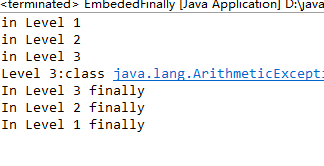异常 (Exception):发生于程序执行期间,表明出现了一个非法的运行状况。许多JDK中的方法在检测到非法情况时,都会抛出一个异常对象。
异常处理的目的是依据实际情况提供不同的错误应对策略与手段,使程序更稳定,更安全。 异常处理的主要用途是提供准确的错误消息,解释失败的原因、位置和错误类型等,同时提供一定的恢复能力,尽可能地保证数据完整性不被破坏,并让程序能继续运行。
动手动脑
请阅读并运行AboutException.java示例,然后通过后面的几页PPT了解Java中实现异常处理的基础知识。
import javax.swing.*; class AboutException { public static void main(String[] a) { int i=1, j=0, k; k=i/j; try { k = i/j; // Causes division-by-zero exception //throw new Exception("Hello.Exception!"); } catch ( ArithmeticException e) { System.out.println("被0除. "+ e.getMessage()); } catch (Exception e) { if (e instanceof ArithmeticException) System.out.println("被0除"); else { System.out.println(e.getMessage()); } } finally { JOptionPane.showConfirmDialog(null,"OK"+k); } } }
把可能会发生错误的代码放进try语句块中。 当程序检测到出现了一个错误时会抛出一个异常对象。异常处理代码会捕获并处理这个错误。 catch语句块中的代码用于处理错误。 当异常发生时,程序控制流程由try语句块跳转到catch语句块。 不管是否有异常发生,finally语句块中的语句始终保证被执行。 如果没有提供合适的异常处理代码,JVM将会结束掉整个应用程序。
java中异常的分类
Throwable类有两个直接子类: Exception:出现的问题是可以被捕获的; Error:系统错误,通常由JVM处理。 可捕获的异常又可以分为两类: (1)Check异常:直接派生自Exception的异常类,必须被捕获或再次声明抛出 (2)Runtime异常:派生自RuntimeException的异常类。使用throw语句可以随时抛出这种异常对象: throw new ArithmeticException(…);
异常多态特性
可以有多个catch语句块,每个代码块捕获一种异常。在某个try块后有两个不同的catch 块捕获两个相同类型的异常是语法错误。 使用catch语句,只能捕获Exception类及其子类的对象。因此,一个捕获Exception对象的catch语句块可以捕获所有“可捕获”的异常。 将catch(Exception e)放在别的catch块前面会使这些catch块都不执行,因此Java不会编译这个程序。
finally的功能
资源泄露:当一个资源不再被某应用程序使用,但此程序并未向系统声明不再使用此资源时发生这种情况 finally语句块主要用于解决资源泄露问题,它位于catch语句块之后,JVM保证它们一定执行。 注意:finally语句块中也可能发生异常,如果这种情况发生,先前的异常被放弃。
动手动脑
public class CatchWho { public static void main(String[] args) { try { try { throw new ArrayIndexOutOfBoundsException(); } catch(ArrayIndexOutOfBoundsException e) { System.out.println( "ArrayIndexOutOfBoundsException" + "/内层try-catch"); } throw new ArithmeticException(); } catch(ArithmeticException e) { System.out.println("发生ArithmeticException"); } catch(ArrayIndexOutOfBoundsException e) { System.out.println( "ArrayIndexOutOfBoundsException" + "/外层try-catch"); } } }

public class CatchWho2 { public static void main(String[] args) { try { try { throw new ArrayIndexOutOfBoundsException(); } catch(ArithmeticException e) { System.out.println( "ArrayIndexOutOfBoundsException" + "/内层try-catch"); } throw new ArithmeticException(); } catch(ArithmeticException e) { System.out.println("发生ArithmeticException"); } catch(ArrayIndexOutOfBoundsException e) { System.out.println( "ArrayIndexOutOfBoundsException" + "/外层try-catch"); } } }

throw出来的错误 java中在第一个错误未被处理的时,不会抛出新的错误;
动手动脑
public class EmbededFinally { public static void main(String args[]) { int result; try { System.out.println("in Level 1"); try { System.out.println("in Level 2"); // result=100/0; //Level 2 try { System.out.println("in Level 3"); result=100/0; //Level 3 } catch (Exception e) { System.out.println("Level 3:" + e.getClass().toString()); } finally { System.out.println("In Level 3 finally"); } // result=100/0; //Level 2 } catch (Exception e) { System.out.println("Level 2:" + e.getClass().toString()); } finally { System.out.println("In Level 2 finally"); } // result = 100 / 0; //level 1 } catch (Exception e) { System.out.println("Level 1:" + e.getClass().toString()); } finally { System.out.println("In Level 1 finally"); } }

当有多层嵌套的finally时,异常在不同的层次抛出 ,在不同的位置抛出,可能会导致不同的finally语句块执行顺序。
辨析:finally语句块一定会执行吗?
public class SystemExitAndFinally { public static void main(String[] args) { try{ System.out.println("in main"); throw new Exception("Exception is thrown in main"); //System.exit(0); } catch(Exception e) { System.out.println(e.getMessage()); System.exit(0); } finally { System.out.println("in finally"); } } }

不一定!!!
如何跟踪异常的传播路径
当程序中出现异常时,JVM会依据方法调用顺序依次查找有关的错误处理程序。 可使用printStackTrace 和 getMessage方法了解异常发生的情况: printStackTrace:打印方法调用堆栈。 每个Throwable类的对象都有一个getMessage方法,它返回一个字串,这个字串是在Exception构造函数中传入的,通常让这一字串包含特定异常的相关信息。
异常是程序中的一些错误,但并不是所有的错误都是异常,并且错误有时候是可以避免的。比如说,你的代码少了一个分号,那么运行出来结果是提示是错误java.lang.Error;如果你用System.out.println(11/0),那么你是因为你用0做了除数,会抛出java.lang.ArithmeticException的异常。
有些异常需要做处理,有些则不需要捕获处理,后面会详细讲到。
Java的程序代码也如此。在编程过程中,首先应当尽可能去避免错误和异常发生,对于不可避免、不可预测的情况则在考虑异常发生时如何处理。
Java中的异常用对象来表示。Java对异常的处理是按异常分类处理的,不同异常有不同的分类,每种异常都对应一个类型(class),每个异常都对应一个异常(类的)对象。
异常类从哪里来?有两个来源,一是Java语言本身定义的一些基本异常类型,二是用户通过继承Exception类或者其子类自己定义的异常。Exception 类及其子类是 Throwable 的一种形式,它指出了合理的应用程序想要捕获的条件。
异常的对象从哪里来呢?有两个来源,一是Java运行时环境自动抛出系统生成的异常,而不管你是否愿意捕获和处理,它总要被抛出!比如除数为0的异常。二是程序员自己抛出的异常,这个异常可以是程序员自己定义的,也可以是Java语言中定义的,用throw 关键字抛出异常,这种异常常用来向调用者汇报异常的一些信息。
异常是针对方法来说的,抛出、声明抛出、捕获和处理异常都是在方法中进行的。